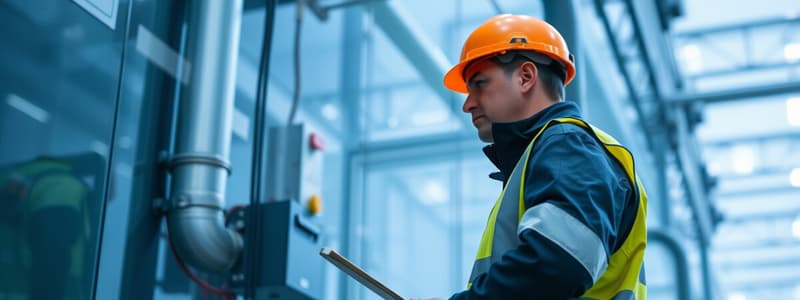Podcast
Questions and Answers
Which of the following best defines industrial security?
Which of the following best defines industrial security?
- Protection of industrial facilities, assets, and personnel from various threats. (correct)
- Protection of digital assets from cyber attacks.
- Administrative controls over employee behavior.
- A process mainly focused on physical security measures.
What component of industrial security specifically addresses the risks associated with employee behavior?
What component of industrial security specifically addresses the risks associated with employee behavior?
- Operational Security (OPSEC)
- Personnel Security (correct)
- Cybersecurity
- Physical Security
Which of the following is NOT a component of physical security?
Which of the following is NOT a component of physical security?
- Firewalls (correct)
- Surveillance technologies
- Perimeter security
- Access control systems
What is the purpose of risk assessment in industrial security?
What is the purpose of risk assessment in industrial security?
Which regulation is primarily associated with occupational safety and health standards?
Which regulation is primarily associated with occupational safety and health standards?
Which technology is primarily used for ensuring the security of information systems?
Which technology is primarily used for ensuring the security of information systems?
Which of the following challenges is associated with industrial security?
Which of the following challenges is associated with industrial security?
What role do emergency response plans play in industrial security?
What role do emergency response plans play in industrial security?
Flashcards are hidden until you start studying
Study Notes
Definition
- Industrial Security: Protection of industrial facilities, assets, and personnel from threats such as theft, sabotage, espionage, and terrorism.
Key Concepts
- Threats: External (terrorism, vandalism) and internal (employee misconduct, industrial espionage).
- Risk Assessment: Identifying vulnerabilities and potential threats to prioritize security measures.
Components of Industrial Security
-
Physical Security:
- Access control (ID cards, biometric systems)
- Surveillance (CCTV, motion detectors)
- Perimeter security (fencing, security guards)
-
Cybersecurity:
- Protection of digital assets and information systems.
- Implementation of firewalls, anti-virus software, and secure networks.
-
Personnel Security:
- Background checks for employees and contractors.
- Training programs on security awareness and emergency response.
-
Operational Security (OPSEC):
- Protection of sensitive operations and information.
- Procedures to minimize risk of data leaks or unauthorized access.
Policies and Procedures
- Security Policies: Documented guidelines outlining security measures and protocols.
- Emergency Response Plans: Procedures for responding to security incidents and crises.
- Incident Reporting: Systems for reporting and documenting security breaches or suspicious activities.
Technologies Used
- Access control systems (Keycards, biometric scanners)
- Alarm systems (Intrusion detectors, fire alarms)
- Surveillance technologies (CCTV, drones)
Compliance and Standards
- Adherence to regulations such as ISO 28000 (supply chain security) and OSHA (Occupational Safety and Health Administration).
- Regular audits and assessments to ensure compliance with industry standards.
Challenges in Industrial Security
- Evolving threat landscape (cyber threats, insider threats)
- Balancing security with operational efficiency.
- Resource allocation for security measures.
Best Practices
- Regular training and drills for employees.
- Continuous monitoring and upgrading of security systems.
- Collaboration with local law enforcement and other security agencies.
Definition
- Industrial Security encompasses the safeguarding of industrial facilities, assets, and personnel against theft, sabotage, espionage, and terrorism.
Key Concepts
- Threats can be categorized into external sources (e.g., terrorism, vandalism) and internal sources (e.g., employee misconduct, industrial espionage).
- Risk Assessment involves identifying vulnerabilities and potential threats to effectively prioritize security measures.
Components of Industrial Security
-
Physical Security includes:
- Access control mechanisms like ID cards and biometric systems to restrict unauthorized entry.
- Surveillance technologies such as CCTV and motion detectors for monitoring premises.
- Perimeter security measures, including fencing and the presence of security guards.
-
Cybersecurity focuses on the defense of digital assets and information systems, utilizing firewalls, antivirus software, and secure network protocols.
-
Personnel Security involves conducting background checks on employees and contractors, along with providing training programs focused on security awareness and emergency response.
-
Operational Security (OPSEC) aims to protect sensitive operations by implementing protocols that minimize data leaks and unauthorized access.
Policies and Procedures
- Security Policies are formal documents that outline security measures and protocols to be followed.
- Emergency Response Plans detail procedures to manage security incidents and crises effectively.
- Incident Reporting systems facilitate the reporting and documentation of security breaches or suspicious activities.
Technologies Used
- Access control systems utilize keycards and biometric scanners to manage entry.
- Alarm systems include intrusion detectors and fire alarms to alert personnel of threats.
- Surveillance technologies involve the use of CCTV and drones for enhanced monitoring.
Compliance and Standards
- Compliance with regulations such as ISO 28000 (focused on supply chain security) and OSHA (Occupational Safety and Health Administration) is essential.
- Regular audits and assessments are necessary to maintain adherence to industry standards.
Challenges in Industrial Security
- The threat landscape is continuously evolving, incorporating new cyber threats and insider risks.
- There is a need to balance robust security measures with operational efficiency.
- Adequate resource allocation for effective security implementation remains a persistent challenge.
Best Practices
- Regular training and drills for employees enhance security preparedness.
- Continuous monitoring and upgrades of security systems are critical to staying ahead of threats.
- Collaboration with local law enforcement and security agencies strengthens overall security efforts.
Studying That Suits You
Use AI to generate personalized quizzes and flashcards to suit your learning preferences.




